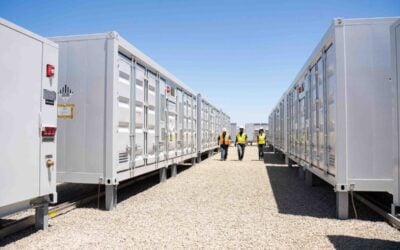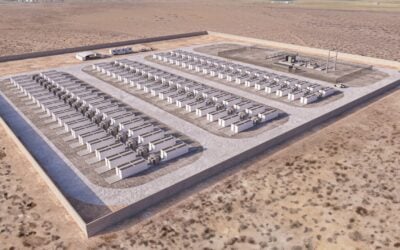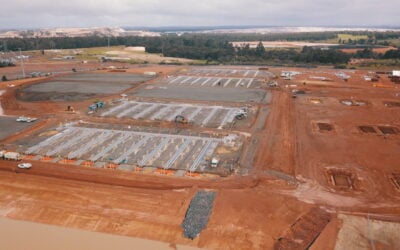
There is “no shortage of investor appetite” and policy support is in place, but there are still some barriers to energy storage deployment on the scale needed to decarbonise Australia’s energy sector.
That was the view of Stephanie Bashir, CEO of energy policy and regulation specialist Nexa Advisory and chair of the morning session at Day One of the Energy Storage Summit Australia in Sydney.
Enjoy 12 months of exclusive analysis
- Regular insight and analysis of the industry’s biggest developments
- In-depth interviews with the industry’s leading figures
- Annual digital subscription to the PV Tech Power journal
- Discounts on Solar Media’s portfolio of events, in-person and virtual
Or continue reading this article for free
Bashir said that Australia has taken “long strides” forward since the Labor Party took power in 2022, in an interview with Energy-Storage.news.
After setting emissions reduction and renewable energy targets, the government has also introduced the Capacity Investment Scheme (CIS) tenders, major procurements of both variable and dispatchable renewable energy that have been expanded to support decarbonisation agendas at both national and state level.
Prime Minister Anthony Albanese’s party has also committed to building out Australia’s transmission infrastructure via the Rewiring the Nation initiative.
“All of these policies are great, they provide the certainty that we didn’t have in the past to get on with things,” Bashir said.
At the same time, “there is no shortage of private investor appetite” to get involved in the renewable energy, energy storage and even transmission sectors in Australia.
“The problems are when you get on the ground. To get these projects through the planning and environmental approval processes, commissioning with the Australian Energy Market Operator (AEMO) and some of these ‘nuts and bolts’ [issues] is when things get much harder, to get projects through,” Bashir said.
“So from a big picture perspective, there’s a lot of talk about Australia having ambitions to be an energy superpower, and that is absolutely something that Australia can do and should do.
“We’ve got the land, we’ve got the critical minerals, we’ve got all the things that basically would make us an Australian energy superpower. But our plans don’t reflect that. Our current plans are very conservative.”
AEMO’s regularly published Integrated System Plan (ISP) has multiple scenario pathways, and its plan for the National Electricity Market (NEM) that is currently being followed is the Step Change scenario, which Bashir describes again as “conservative”.
Step Change would enable Australia to meet coal plant closure timelines and meet tight reliability standards for electricity supply but lacks the ambition the country would need to become that “energy superpower,” Bashir argued.
One of Australia’s biggest coal power plants, Eraring, in New South Wales, was originally scheduled for closure in 2030, but its owner, Origin Energy, brought that forward to 2025 as it becomes increasingly uneconomic to maintain the 42-year-old asset.
However, building the renewable energy and storage infrastructure that could replace Eraring has proven difficult, with the exception of the flagship Waratah Super Battery, given what Bashir calls “roadblocks” around obtaining planning approvals and meeting AEMO commissioning requirements.
“These types of roadblocks are fairly and squarely in the hands of government to expedite and then make sure that we’re not just building to the timeline to close power stations (which we’re failing miserably as a result) but also to have a bit more ambition to be the energy superpower we actually can be.”
The good news is that Australia has the policy mechanisms in place and the technologies available to achieve that more ambitious goal.
“We just need to get on with it,” Bashir said.
Read an extract of Stephanie Bashir’s article, ‘Australia needs renewables, transmission and lots of storage to quit fossil fuels,’ which was published in Vol.37 of PV Tech Power, Solar Media’s quarterly journal covering the solar and storage industries. ESN Premium subscribers can read the journal in full as part of their subscription.
Architecture of Australia’s Capacity Investment Scheme in focus
The Capacity Investment Scheme (CIS) was a major talking point throughout today’s event. To kick things off, Salim Mazouz from Australia’s government Department of Climate Change, Energy, the Environment and Water (DCEEW) gave a keynote address about its design and aims.
The CIS will incentivise the deployment of 32GW of clean energy, including 9GW of firm dispatchable renewables and 23GW of variable generation—potentially also including hybrid projects in the latter.
It is “designed to reduce price risk and provide investors with a little bit more certainty,” said Mazouz, who heads up DCEEW’s CIS Branch.
At the same time, the scheme has been expanded to include bilateral Renewable Energy Transformation Agreements (RETAs) between Australia’s Commonwealth government and its counterparts at state and territory level, aimed at helping remove barriers to deployment of ever-greater clean energy capacity.
The Commonwealth takes on the downside when prices drop low, and conversely shares in revenues when prices go above an agreed ceiling, in what Mazouz said could be thought of as an “equilibrating mechanism”.
“When you think about it from the taxpayer’s perspective, if we’re successful, we manage to push in a lot of renewables, prices come down and we’ve got a [more] orderly transition than we would otherwise have,” Mazouz said.
“When the capacity investment scheme costs the taxpayer a little bit more, but we’ve been successful, and energy prices are low, should this orderly transition happen and prices end up on the higher end of the scale, well, then taxpayers get money back from the system.”
The expanded CIS has been built upon the foundations of two pilot tenders which were focused on energy storage, including the first in New South Wales (NSW) which resulted in awards for six large-scale battery energy storage system (BESS) projects and one virtual power plant (VPP), and an ongoing pilot scheme for Victoria and South Australia.
“We received an overwhelming response to this tender, demonstrating the depth and vibrancy of the energy storage industry in Australia,” Salim Mazouz said.
Stay tuned to Energy-Storage.news for more coverage of the inaugural Energy Storage Summit Australia in the coming days and weeks...







